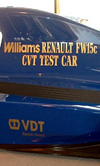Sequential gearbox origins
 In previous Monitor features we have touched upon the automated gearshift of a modern race car and attempted to put it into historical context, but how many of its mechanical design features represent new thinking ?
In previous Monitor features we have touched upon the automated gearshift of a modern race car and attempted to put it into historical context, but how many of its mechanical design features represent new thinking ?
Central to its function has been the move from a H-gate to sequential gear selection, for with this it is much easier to provide powered control of the actual selection mechanism. In the modern box this normally takes the form of a drum, with a pathway machined into it, whose axis is parallel to that of the actual gear shafts. Depending on the type of system fitted to the car, as the driver pulls at his steering wheel paddles, an actuator will be operated either by pneumatic, hydraulic, or fully electric means, which will in turn move a peg or lever that engages in the track of the drum, and so rotates it. As it does so it will sequentially pick up conventional selector forks that will move face dogs into engagement with the next gear.
The historical ancestor of the concept – in the racing world – is the gearbox designed for the Cisitalia GP car for which Porsche was responsible, immediately post war. This was never raced, but in 1956 a similar system was adopted for the first single seater Lotus, the front engine type 12 Formula Two car. For his first tentative steps into single seater racing, Chapman boldly commissioned a bespoke unit that was typically somewhat in advance of anything else available ‘off the shelf’ at the time – of which there was precious little in any case. It was, in effect, a scaled up motorcycle unit, with five forward speeds occupying no more than 80 mm in length, and an all up weight of just 22,5 kg. Shaft centres were 99 mm with a further 30 mm step up available from a hypoid final drive. In its original form the manually operated unit was fully sequential. One set of gears was permanently splined to the pinion shaft and the other free to rotate about the first motion shaft. Rather than using a rotating drum, selection was by a sliding sleeve that sat over the first motion shaft. On this was formed a six sided spline which engaged with similar splines formed on the inner annulus of each gear. Bronze spacers between each gear formed a neutral position, with the cockpit lever always returning to the same, central, neutral position after down- or up-changes.
The ‘box was notoriously variable in its reliability, gaining the nome de plume of ‘Lotus Queerbox’ something that has been put down variously over the years to poor lubrication, undersized gears, and reuse of out of life parts in what was still an organisation that existed on the margins of viability. By 1961, when it was replaced by a ZF unit, it had been adapted for mid-engine use, the final drive had been changed to a spiral form after lubrication issues with the hypoid, and the change had been modified so that the lever now migrated as gears were selected, two racks being required in the system to achieve this.
But Chapman never completely gave up on his original transmission concept. In 1974, by which time Formula One Lotus’s were using the same dog clutch H-shift Hewland FG400 gearboxes as everyone else, he introduced a change system operated by a button on the gearlever, thus deleting the use of a conventional clutch pedal for all but starting. The idea was to speed up changes and reduce the time spent in freewheel, at the same time allowing the drivers to left foot brake. Even then this was recognised as a potentially faster way around the lap, but the system was driven by the starter motor with the conventional clutch release operated electrically from this, and instead of clutches gear shifting the end result was more often a series of burnt out motors and electrical short circuits that killed the engine.
Still he pursued his two pedal philosophy and in 1978 reintroduced a version of the ‘queerbox’. Instead of using splines, engagement was now by ball bearings thrust into position with each gear by a bobbin running inside the input shaft. Ground effect aerodynamics were just beginning to be applied to the type 78 and 79 and clutchless, two pedal control, by which pitch change under acceleration and deceleration could be more closely controlled, suddenly opened up a whole new relevance for the technology...
Written by Peter Elleray.